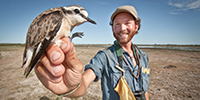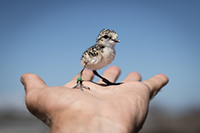© Universität Bielefeld
uni.news
Published on
22. Juni 2017
Category
General
On polygamous females and single-parent males
Behavioural researchers at Bielefeld University are studying plovers
Male plovers survive more successfully in the wild than females. Behavioural researchers at Bielefeld University have studied how sex biases develop across the life span of the plover. They report on the consequences of the surplus of males for rearing chicks in the research journal ‘Proceedings of the National Academy of Sciences’.
 The biologist Luke Eberhart-Phillips from Bielefeld University’s Department of Animal Behaviour has been studying sex biases among birds for four years. One of these studies addresses bird colonies in Madagascar. The doctoral student is carrying out research at Bielefeld University and at the Max Planck Institute for Ornithology in Seewiesen (Bavaria). For the current study, he examined the snowy plover (Charadrius nivosus) in Bahía de Ceuta on the north-west coast of Mexico. ‘Our aim was to analyse the survival rate and the mating behaviour of the plover in this region,’ says Eberhart-Phillips.
The biologist Luke Eberhart-Phillips from Bielefeld University’s Department of Animal Behaviour has been studying sex biases among birds for four years. One of these studies addresses bird colonies in Madagascar. The doctoral student is carrying out research at Bielefeld University and at the Max Planck Institute for Ornithology in Seewiesen (Bavaria). For the current study, he examined the snowy plover (Charadrius nivosus) in Bahía de Ceuta on the north-west coast of Mexico. ‘Our aim was to analyse the survival rate and the mating behaviour of the plover in this region,’ says Eberhart-Phillips.
‘Sex biases play an important role in the reproduction system and the growth rate of a population and thereby in whether females or males look after the nestlings,’ says Professor Dr. Oliver Krüger, the head of the Department of Animal Behaviour. ‘When the ratio is imbalanced and there are, for example, more females, it is more difficult for them to find a partner. This can lead to a massive decline in the population,’ according to the biologist.
 ‘We asked ourselves during which phases of the bird’s life the sex bias changes,’ says Eberhart-Phillips, the main author of the new study ‘Do particularly many females or male die shortly after hatching? Or is childhood or adulthood decisive and critical for one of the sexes?’For the new study, the Bielefeld researchers worked in cooperation with colleagues from Germany, Great Britain, Mexico, and the USA. Together with these researchers, Luke Eberhart-Phillips attached distinctive coloured anklets to mark 1,259 plovers living in the wild. As a result, when observing the birds with binoculars or telescopes, it was always clear which birds were in sight. Male and female snowy plovers are very similar to each other and can be distinguished only during the breeding period. This is why the researchers took blood samples to determine sex genetically.
‘We asked ourselves during which phases of the bird’s life the sex bias changes,’ says Eberhart-Phillips, the main author of the new study ‘Do particularly many females or male die shortly after hatching? Or is childhood or adulthood decisive and critical for one of the sexes?’For the new study, the Bielefeld researchers worked in cooperation with colleagues from Germany, Great Britain, Mexico, and the USA. Together with these researchers, Luke Eberhart-Phillips attached distinctive coloured anklets to mark 1,259 plovers living in the wild. As a result, when observing the birds with binoculars or telescopes, it was always clear which birds were in sight. Male and female snowy plovers are very similar to each other and can be distinguished only during the breeding period. This is why the researchers took blood samples to determine sex genetically.
Eberhart-Phillips points out that one central outcome of the study is that ‘male plovers in the population studied have a higher chance of survival than females in all phases of life. The result is a sex bias of only 37 per cent females among adult plovers.’ Particularly in their youth (period before the first moult), the females have a third lower rate of survival. The scientists suspect that this is because males have a greater bodyweight when they hatch and show a higher growth rate. This may grant them an advantage over females.
‘The study confirms the long-standing theory on an equal distribution of the sexes at birth,’ says Oliver Krüger. ‘Mothers bear an equal number of females and males, because that is the best evolutionary strategy even when the sex biases that emerge topple the balance in adulthood.’
The surplus of males makes it easier for female plovers to find a partner than it is for males. ‘This makes it possible for females to change partners frequently. Hence they live polygamously and split up from their partners as soon as the offspring have hatched.’ As a result, the males become ‘single parents’. ‘They look after the young birds instead of seeking a new female,’ reports Luke Eberhart-Phillips. Hence, according to the biologist, mating behaviour among birds depends on the survival rate of that particular sex.
These findings could play an important role in the protection of species. ‘Nature conservationists usually assume equal chances of survival for both sexes. Our results question this,’ says Krüger. ‘Our study shows that endangered populations can decline far more quickly than we had thought if they show polygamous mating behaviour.’
Original publication:
Luke J. Eberhart-Phillips, Clemens Küpper, Tom E. X. Miller, Medardo Cruz-López, Kathryn H. Maher, Natalie dos Remedios, Martin A. Stoffel, Joseph I. Hoffman, Oliver Krüger, and Tamás Székely: Sex-specific early survival drives adult sex ratio bias in snowy plovers and impacts mating system and population growth. Proceedings of the National Academy of Sciences. http://doi.org/10.1073/pnas.1620043114, published on the 20th of June 2017.
Further information:
• Department of Animal Behaviour: http://www.uni-bielefeld.de/biologie/animalbehaviour/home.html
• ‘Study on blue tits: Smell first, and then beg’ (Press release from 12th of May 2017): http://bit.ly/2sEMjL2
Male plovers survive more successfully in the wild than females. Behavioural researchers at Bielefeld University have studied how sex biases develop across the life span of the plover. They report on the consequences of the surplus of males for rearing chicks in the research journal ‘Proceedings of the National Academy of Sciences’.
The behavioural researcher Luke Eberhart-Phillips – here in Madagascar – has spent four years studying how plovers develop in their beach-side colonies throughout the world.
Photo: Bielefeld University/ L. Eberhart-Phillips
Photo: Bielefeld University/ L. Eberhart-Phillips
‘Sex biases play an important role in the reproduction system and the growth rate of a population and thereby in whether females or males look after the nestlings,’ says Professor Dr. Oliver Krüger, the head of the Department of Animal Behaviour. ‘When the ratio is imbalanced and there are, for example, more females, it is more difficult for them to find a partner. This can lead to a massive decline in the population,’ according to the biologist.
The study shows how female members of a plover population in Mexico respond to a local surplus of males with polygamy.
Photo: Bielefeld University/ L. Eberhart-Phillips
Photo: Bielefeld University/ L. Eberhart-Phillips
Eberhart-Phillips points out that one central outcome of the study is that ‘male plovers in the population studied have a higher chance of survival than females in all phases of life. The result is a sex bias of only 37 per cent females among adult plovers.’ Particularly in their youth (period before the first moult), the females have a third lower rate of survival. The scientists suspect that this is because males have a greater bodyweight when they hatch and show a higher growth rate. This may grant them an advantage over females.
‘The study confirms the long-standing theory on an equal distribution of the sexes at birth,’ says Oliver Krüger. ‘Mothers bear an equal number of females and males, because that is the best evolutionary strategy even when the sex biases that emerge topple the balance in adulthood.’
The surplus of males makes it easier for female plovers to find a partner than it is for males. ‘This makes it possible for females to change partners frequently. Hence they live polygamously and split up from their partners as soon as the offspring have hatched.’ As a result, the males become ‘single parents’. ‘They look after the young birds instead of seeking a new female,’ reports Luke Eberhart-Phillips. Hence, according to the biologist, mating behaviour among birds depends on the survival rate of that particular sex.
These findings could play an important role in the protection of species. ‘Nature conservationists usually assume equal chances of survival for both sexes. Our results question this,’ says Krüger. ‘Our study shows that endangered populations can decline far more quickly than we had thought if they show polygamous mating behaviour.’
Original publication:
Luke J. Eberhart-Phillips, Clemens Küpper, Tom E. X. Miller, Medardo Cruz-López, Kathryn H. Maher, Natalie dos Remedios, Martin A. Stoffel, Joseph I. Hoffman, Oliver Krüger, and Tamás Székely: Sex-specific early survival drives adult sex ratio bias in snowy plovers and impacts mating system and population growth. Proceedings of the National Academy of Sciences. http://doi.org/10.1073/pnas.1620043114, published on the 20th of June 2017.
Further information:
• Department of Animal Behaviour: http://www.uni-bielefeld.de/biologie/animalbehaviour/home.html
• ‘Study on blue tits: Smell first, and then beg’ (Press release from 12th of May 2017): http://bit.ly/2sEMjL2